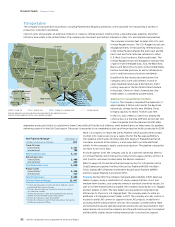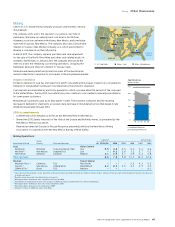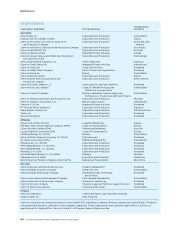Chevron 2010 Annual Report Download - page 64
Download and view the complete annual report
Please find page 64 of the 2010 Chevron annual report below. You can navigate through the pages in the report by either clicking on the pages listed below, or by using the keyword search tool below to find specific information within the annual report.
62 Chevron Corporation 2010 Supplement to the Annual Report
Reference
Glossary of Energy and Financial Terms
Energy Terms
Acreage Land leased for crude oil and natural gas exploration
and production.
Additives Chemicals to control engine deposits and improve
lubricating performance.
Barrels of Oil-Equivalent A unit of measure to quantify crude oil,
natural gas liquids and natural gas amounts using the same
basis. Natural gas volumes are converted to barrels on the basis
of energy content. See oil-equivalent gas and production.
Biofuel Any fuel that is derived from biomass – recently living
organisms or their metabolic byproducts – from sources such
as farming, forestry, and biodegradable industrial and
municipal waste. See renewables.
Condensate Hydrocarbons that are in a gaseous state at
reservoir conditions but condense into liquid as they travel
up the well bore and reach surface conditions.
Development Drilling, construction and related activities
following discovery that are necessary to begin production
and transportation of crude oil and/or natural gas.
Enhanced Recovery Techniques used to increase or prolong
production from crude oil and natural gas fields.
Exploration Searching for crude oil and/or natural gas by
utilizing geological and topographical studies, geophysical
and seismic surveys, and drilling of wells.
Gas-to-Liquids A process that converts natural gas into
high-quality transportation fuels and other products.
Liquefied Natural Gas (LNG) Natural gas that is liquefied under
extremely cold temperatures to facilitate storage or transportation
in specially designed vessels.
Liquefied Petroleum Gas (LPG) Light gases, such as butane
and propane, that can be maintained as liquids while
under pressure.
Natural Gas Liquids (NGL) Separated from natural gas, these
include ethane, propane, butane and natural gasoline.
Oil-Equivalent Gas The volume of natural gas needed to
generate the equivalent amount of heat as a barrel of crude
oil. Approximately 6,000 cubic feet of natural gas is equivalent
to one barrel of crude oil.
Oil Sands Naturally occurring mixture of bitumen (a heavy,
viscous form of crude oil), water, sand and clay. Using hydro-
processing technology, bitumen can be refined to yield
synthetic oil.
Oil Shale Very fine grained sedimentary rocks containing a high
proportion of organic matter called kerogen, which may be con-
verted into synthetic crude oil or natural gas.
Petrochemicals Compounds derived from petroleum. These include
aromatics, which are used to make plastics, adhesives, synthetic
fibers and household detergents; and olefins, which are used to
make packaging, plastic pipes, tires, batteries, household deter-
gents and synthetic motor oils.
Production Total production refers to all the crude oil (including
synthetic oil), natural gas liquids and natural gas produced from
a property. Gross production is the company’s share of total pro-
duction before deducting both royalties paid to landowners and
a government’s agreed-upon share of production under a PSC.
Net production is gross production minus both royalties paid to
landowners and a government’s agreed-upon share of production
under a PSC. Oil-equivalent production is the sum of the barrels
of liquids and the oil-equivalent barrels of natural gas produced.
See barrels of oil-equivalent, oil-equivalent gas, and production-
sharing contract.
Production-Sharing Contract (PSC) An agreement between a
government and a contractor (generally an oil and gas company)
whereby production is shared between the parties in a pre-
arranged manner. The contractor typically incurs all exploration,
development and production costs that are subsequently recover-
able out of an agreed-upon share of any future PSC production,
referred to as cost recovery oil and/or gas. Any remaining produc-
tion, referred to as profit oil and/or gas, is shared between the
parties on an agreed-upon basis as stipulated in the PSC. The gov-
ernment also may retain a share of PSC production as a royalty
payment, and the contractor may owe income taxes on its portion
of the profit oil and/or gas. The contractor’s share of PSC oil and/
or gas production and reserves varies over time, as it is dependent
on prices, costs and specific PSC terms.
Refinery Utilization Represents average crude oil consumed in fuel
and asphalt refineries for the year expressed as a percentage of
the refineries’ average annual crude unit capacity.
Renewables Energy resources that are not depleted when
consumed or converted into other forms of energy (e.g., solar,
geothermal, ocean and tide, wind, hydroelectric power, biofuels,
and hydrogen).
Reserves Crude oil or natural gas contained in underground rock
formations called reservoirs and saleable hydrocarbons extracted
from oil sands, shale, coalbeds or other nonrenewable natural
resources that are intended to be upgraded into synthetic oil or
gas. Proved reserves are the estimated quantities that geoscience
and engineering data demonstrate with reasonable certainty to
be economically producible in the future from known reservoirs
under existing economic conditions, operating methods and gov-
ernment regulations. Estimates change as additional information
becomes available. Oil-equivalent reserves are the sum of the
liquids reserves and the oil-equivalent gas reserves. See barrels
of oil-equivalent and oil-equivalent gas.
The company only discloses proved reserves in its filings with the
U.S. Securities and Exchange Commission (SEC). Certain terms,
such as “probable” or “possible” reserves, “potentially recover-
able” volumes, and “resources,” among others, may be used to
describe certain oil and gas properties in this document, which is
not filed with the SEC. These other terms are used because they
are common to the industry, are measures considered by manage-
ment to be important in making capital investment and operating
decisions, and provide some indication to stockholders of the
potential ultimate recovery of oil and gas from properties in
which the company has an interest. In that regard, potentially
recoverable volumes are those that can be produced using all
known primary and enhanced recovery methods. Investors should
refer to proved reserves disclosures in Chevron’s Annual Report
on Form 10-K for the year ended December 31, 2010.


















